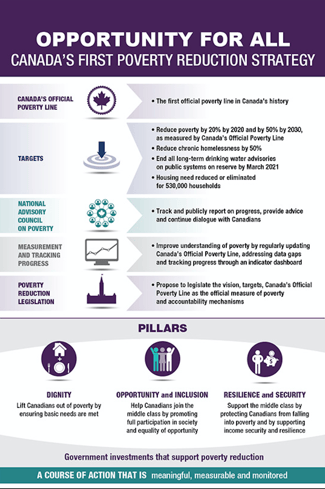The Government of Canada’s first Poverty Reduction Strategy, Opportunity For All, was released on August 21, 2018 in Vancouver, BC. Based on a vision of a Canada without poverty, and on the principle that all Canadians deserve a fair and real chance to succeed and live with dignity; the strategy commits to strengthening the middle class and helping those who are working hard to join it. Informed by an extensive community engagement process, Opportunity For All is organized by three pillars, establishing a working definition of poverty and official income poverty line, and a commitment to reducing the poverty rate in Canada by 50% by 2030.
The strategy builds on investments made by the Government since 2015 that support children, seniors, lower-wage workers and other vulnerable Canadians, which include:
- The Canada Child Benefit, which provides money to parents each month, tax-free;
- The Canada Workers Benefit, a strengthened version of the Working Income Tax Benefit;
- Canada’s first National Housing Strategy, a 10-year, $40-billion plan which will aims to reduce chronic homelessness by 50 percent;
- The increase to the Guaranteed Income Supplement by up to $947 per year, providing greater income security for close to 900,000 low-income seniors; and,
- Restoration of the age of eligibility for Old Age Security and the Guaranteed Income Supplement (GIS) from 67 to 65.

Opportunity For All’s extensive community engagement process elicited three major themes, which now form the three pillars of the Strategy:
- Dignity: Lifting Canadians out of poverty by ensuring basic needs – such as safe and affordable housing, healthy food, and healthcare – are met;
- Opportunity and Inclusion: Helping Canadians join the middle class by promoting full participation in society and equality of opportunity;
- Resilience and Security: Supporting the middle class by protecting Canadians from falling into poverty and by supporting income security and resilience.
The Government of Canada’s defines poverty as “the condition of a person who is deprived of the resources, means, choices and power necessary to acquire and maintain a basic level of living standards and to facilitate integration and participation in society.”
Opportunity For All introduces a national and official measure of income poverty: Canada’s Official Poverty Line, which will be created based on updates to the current Market Basket Measure (MBM). It will be calculated based on the costs of a basket of goods and services (including shelter, transportation, food, and clothing) that individuals and families require to meet their basic needs and achieve a modest standard of living. Thresholds will be developed for 50 regions across Canada, including 19 communities and the three territories, and will be updated annually to account for inflation.
Using a baseline year of 2015, this measure will track progress toward two major targets, as aligned with the United Nations Sustainable Development Goals:
- Reduce the poverty rate by 20% by 2020; and
- Reduce the poverty rate by 50% by 2030.
To roll out the strategy, the Government of Canada plans to work closely with partners across all parts of society, including provinces, territories, Indigenous peoples, communities, academics, the private sector, and people with lived experience, in order to coordinate efforts, address mutual priorities, and share data and best practices.
Moving forward, the Government of Canada plans to establish an independent National Advisory Council on Poverty, which will continue the national dialogue with Canadians on poverty, provide advice to the Minister of Families, Children and Social Development, and track and report on progress. The Government will also introduce legislation (expected in fall 2018) to entrench Canada’s Official Poverty Line, its targets, and the National Advisory Council on Poverty into law.
Stay tuned for upcoming learning opportunities, resources, and blogs related to Opportunity for All – Canada’s First Poverty Reduction Strategy, on the Tamarack website.
Take Your Learning Further:
- Opportunity for All – Canada’s First Poverty Reduction Strategy
- Reflections and Responses
- Maytree - The First Canada-wide Poverty Reduction Strategy Sets Us On a Promising Path Forward
- Miles Corak - Ask Yourself Two Questions While Reading Canada’s Poverty Reduction Strategy, Canada’s Poverty Reduction Strategy Adopts the United Nations Sustainable Development Goal to End Poverty and Canada’s Official Poverty Line: What is It? How Could it be Better?
- Vibrant Community Calgary’s Response to "Opportunity For All – Canada’s First Poverty Reduction Strategy"
- Global News - Calgary advocate hopes groups focus on new Canadian poverty measure
- Macleans - Is the Liberals’ federal poverty-reduction strategy even really a strategy?
- Citizens for Public Justice (CPJ) lauds the launch of a federal poverty strategy
- Canada Without Poverty: Country’s first national poverty strategy acts as a foundation for a Canada without poverty
- Other Resources and Media:
- CTV National News: Ottawa’s Anti-Poverty Strategy
- CBC News: Liberals Vow to Lift 2 Million Canadians out of Poverty by 2030, with No New Spending
- Globe and Mail: Politics Briefing – Defining Poverty in Canada
- University of Calgary: Social Policy Trends – Canada’s Official Poverty Line
- Calgary Herald: Creating opportunity for all in battle against poverty





